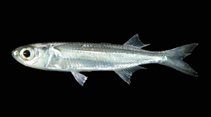| Family: |
Atherinidae (Silversides), subfamily: Atherinomorinae |
| Max. size: |
11 cm SL (male/unsexed) |
| Environment: |
demersal; brackish; marine; depth range 0 - 4 m, oceanodromous |
| Distribution: |
Indo-West Pacific: from Comoro Is., Madagascar, Seychelles, Sri Lanka, Thailand (Andaman Sea), Indonesia, Papua New Guinea, Vanuatu and New Caledonia. |
| Diagnosis: |
Dorsal spines (total): 5-7; Dorsal soft rays (total): 8-11; Anal spines: 11-14; Vertebrae: 37-40. This species is distinguished by the following set of characters: ascending process of the premaxilla short and blunt, its height about two times maximum width, shorter than horizontal length of premaxilla, its height about 2/5 of the horizontal length; premaxilla has a single lateral process; posterior upper margin of dentary with a small process; posterior margin of midlateral scales double or triple truncate; pit on midlateral scales rounded, rarely oval; large head, 25-32% SL; midlateral scales 35-38; total vertebrae 37-40; gill rakers on lower arch 20-24; midlateral band is narrow, width about 1/2 to 3/4 that of midlateral scale, its lower margin not reaching to lower margin of midlateral scale at the level of anal-fin origin (width of midlateral band 12-21% of body depth and 33-59% of caudal peduncle depth at the level of anal-fin origin). Colour of head and body greenish gray or whitish dorsally, brilliant silver laterally; dorsal and dorsolateral scale pockets fringed with black (not distinct in some
specimens); a midlateral band silver or glossy indigo blue, the margin of its upper edge is light yellow or light green; there are small black dots ventrolaterally on the body which may be absent; the snout, pectoral-fin base, and posterior margin of caudal fin are blackish; fin membranes are hyaline (Ref. 121273). |
| Biology: |
Inhabits shallow coastal waters (Ref. 3302); broadly distributed throughout mangrove estuaries to the open coast (Ref. 93954). Occurs in schools along calm shorelines (Ref. 37816). Important as forage food species to larger commercial fish and as bait fish (Ref. 3302). |
| IUCN Red List Status: |
Least Concern (LC); Date assessed: 23 June 2016 Ref. (130435)
|
| Threat to humans: |
harmless |
Source and more info: www.fishbase.org. For personal, classroom, and other internal use only. Not for publication.

